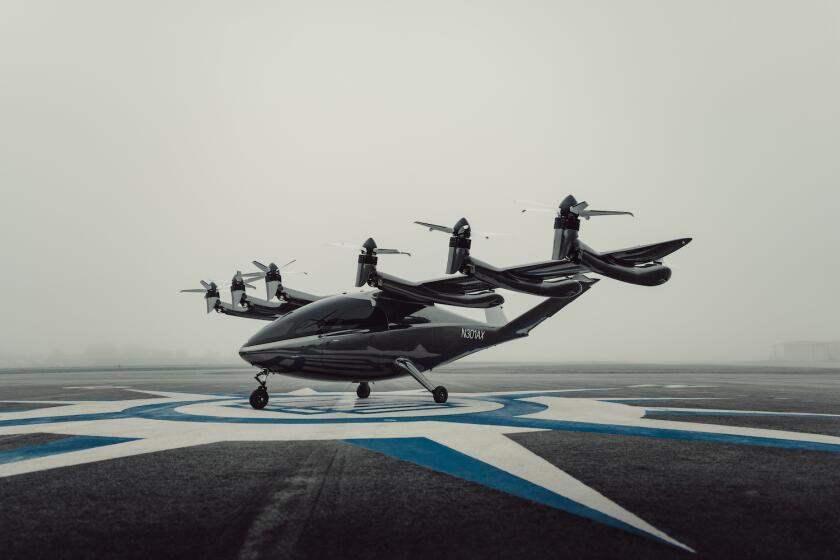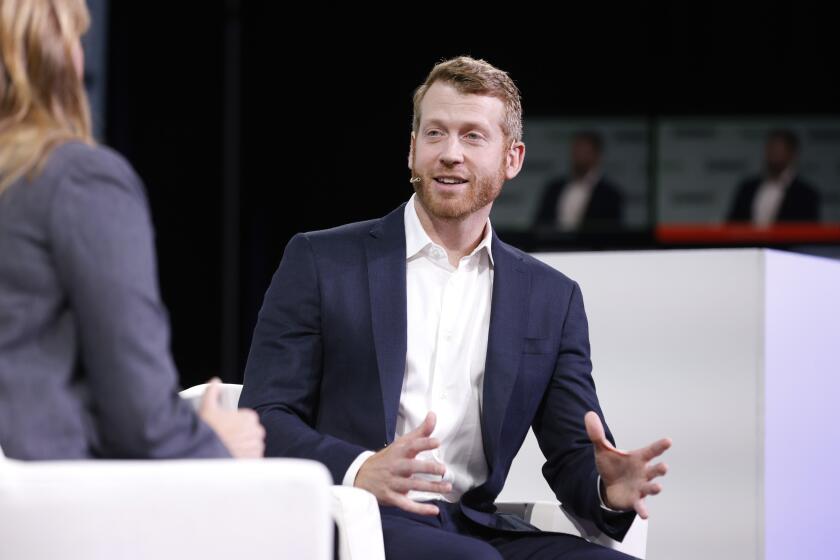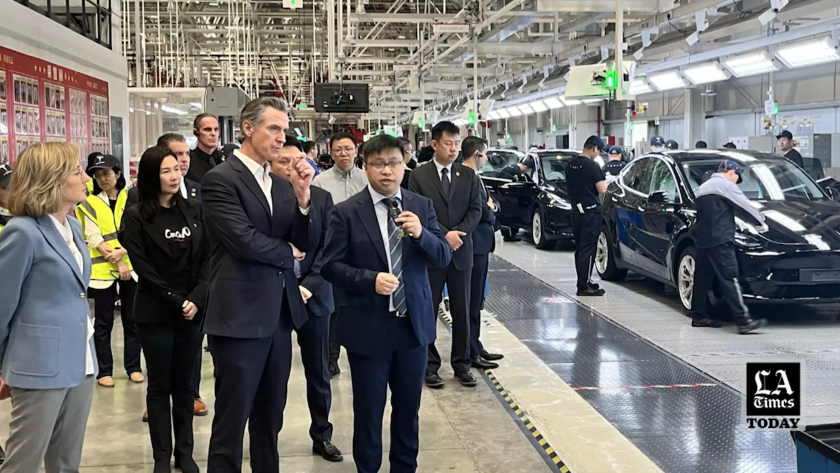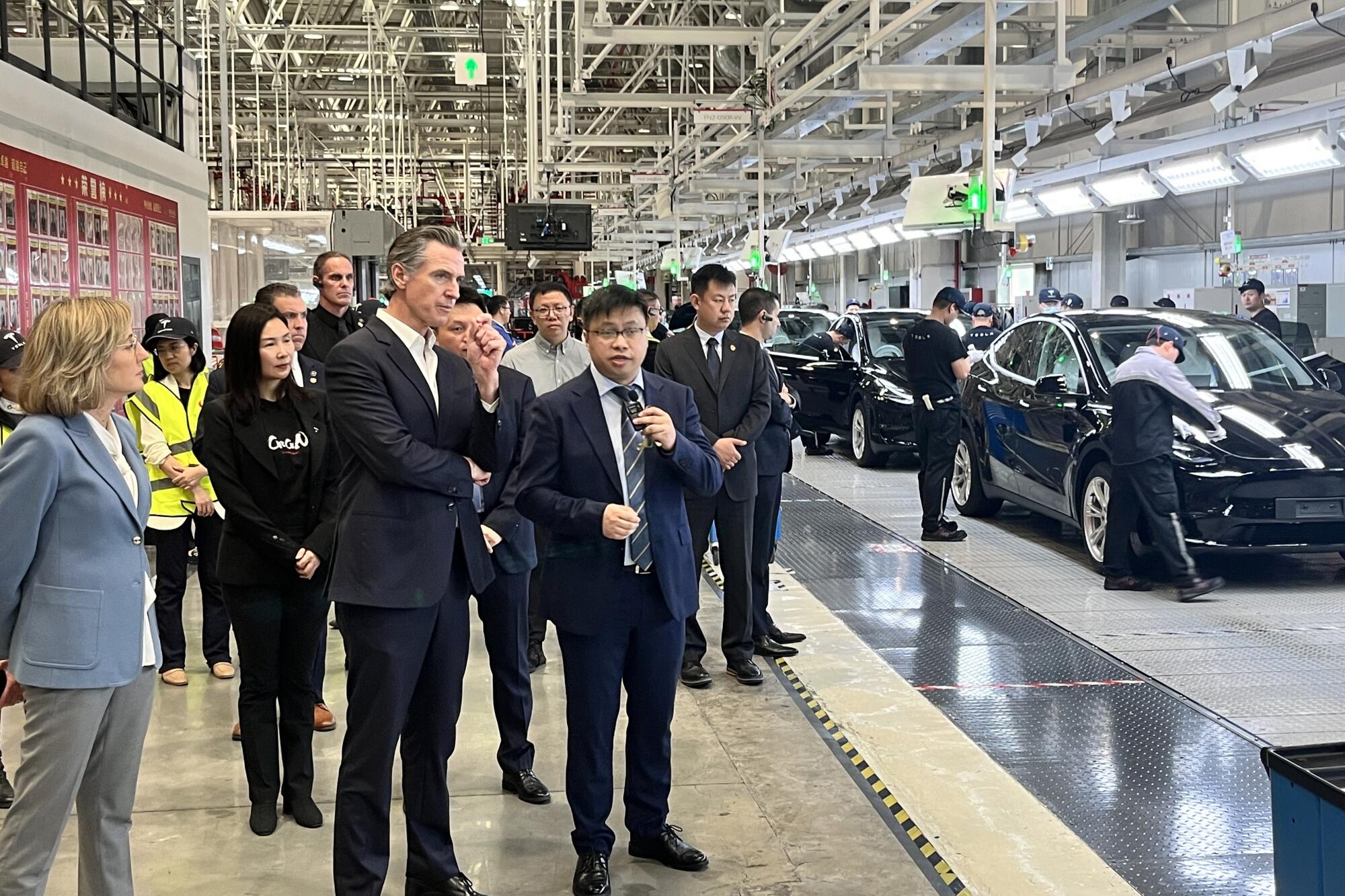
- Share via
SHANGHAI — California Gov. Gavin Newsom walked out of the Tesla gigafactory in China last month feeling jazzed about the future.
A future where people do a lot less driving, instead being whisked around by autonomous cars and flying taxis. A future where, he said, the “entire transportation system is completely reorganized.”
“I think it’s going to come very fast,” Newsom said to reporters on the last day of his trip to China promoting clean energy partnerships with California.
“With AI in particular aiding this advancement, I think it’s just going to explode and you’re going to start seeing driverless flying cars as well.”
Electric air taxis are coming to Los Angeles. The city and FAA will decide if this is a grand new era in transportation or a small novelty for the rich.
Newsom made it clear that he’s committed to keeping California the global leader in the development of autonomous technology and said the state shouldn’t “cede the future” to other countries or states.
A tech-friendly, entrepreneurial streak has been one of Newsom’s hallmarks since he entered politics. As lieutenant governor in 2011, he famously set up his San Francisco office in a private hub of tech start-ups. Newsom boasts of having bought one of the first Teslas ever sold, and has had a longstanding relationship with Elon Musk, whom he calls “one of the world’s great innovators.”
But the governor’s effusive comments about autonomous vehicles come as the technology is causing outrage in some California cities, putting Newsom in conflict with many fellow Democrats who are calling for more oversight of the robotic cars on public roads. He’s clashing with mayors and other local officials who want more control over the expansion of robotaxis in their cities, as well as with state lawmakers who believe California’s system for regulating autonomous vehicles is insufficient.

The friction is growing as autonomous vehicle companies ramp up their lobbying in Sacramento. Cruise, Waymo, Motional and the Autonomous Vehicle Industry Assn. collectively spent about $2.4 million on lobbying the state government in the first nine months of this year — more than three times the $671,579 they spent lobbying in all of last year, according to disclosures filed with the Secretary of State. Much of that increase is due to a huge jump in spending by Waymo, the business owned by Google’s parent company that operates robotaxis in San Francisco and Santa Monica, with plans to expand to other parts of L.A. this month.
Skepticism from local officials has intensified since a Cruise robotaxi dragged a person down a San Francisco street last month, and the company allegedly failed to disclose footage of the wreck. The DMV suspended Cruise’s permits and the General Motors-owned company announced it is suspending U.S. operations while it works to “rebuild public trust.” It recalled its autonomous fleet to perform a software update.
A Cruise robotaxi dragged an injured woman 20 feet. The company misled reporters about the facts, and maybe state regulators too.
On Nov. 1, Los Angeles Mayor Karen Bass wrote a fiery letter to state regulators saying the city wants more say in regulating driverless taxis and she criticized the state for a lack of attention to “public safety, road safety, and other serious concerns.”
“To date, local jurisdictions like Los Angeles have had little to no input in AV deployment and are already seeing significant harm and disruption,” Bass wrote to the state Public Utilities Commission, which approved a massive expansion of robotaxis in August.
Newsom appoints the members of the Public Utilities Commission and oversees the Department of Motor Vehicles, the two agencies tasked with regulating autonomous vehicles. He told reporters he agreed with the DMV’s decision to ban Cruise from San Francisco streets following the crash that left a pedestrian seriously injured.
Even before the Cruise debacle, city officials in San Francisco criticized the state’s move to grow the presence of autonomous vehicles. The fire chief complained that robotaxis are a danger to emergency response because they stop in traffic, pull up too close to firetrucks that are unloading equipment and block firehouse driveways. The police officers union also raised concerns about their expansion. After the Public Utilities Commission approved the expansion, San Francisco’s city attorney filed motions asking it to reverse course, which the commission declined to do.
Now a state lawmaker is pressing the DMV for more information on how it permits autonomous vehicles, how it addresses safety concerns and why it suspended Cruise’s permit. The formal inquiry by state Sen. Dave Cortese (D-San Jose) could portend hearings or legislation on autonomous vehicles after the Legislature reconvenes in January.
“All of us in public service would like to intervene and prevent things from happening and not have tragedy dictate an acceleration of remedies. But if we don’t hurry that’s what’s going to happen,” Cortese said in an interview.
He said California’s structure of having two agencies tasked with regulating driverless cars is problematic.
“I believe we need a single executive agency that deals with autonomous vehicles much like the FAA deals with air travel, commercial and private,” Cortese said. “We don’t have the infrastructure set up to monitor what’s going on or hold people accountable.”
Newsom defended the state’s oversight during his conversation with reporters outside the Shanghai Tesla plant.
“The DMV has built a whole new shop in terms of organizing around making sure people are safe,” he said. “But autonomy is the future.”
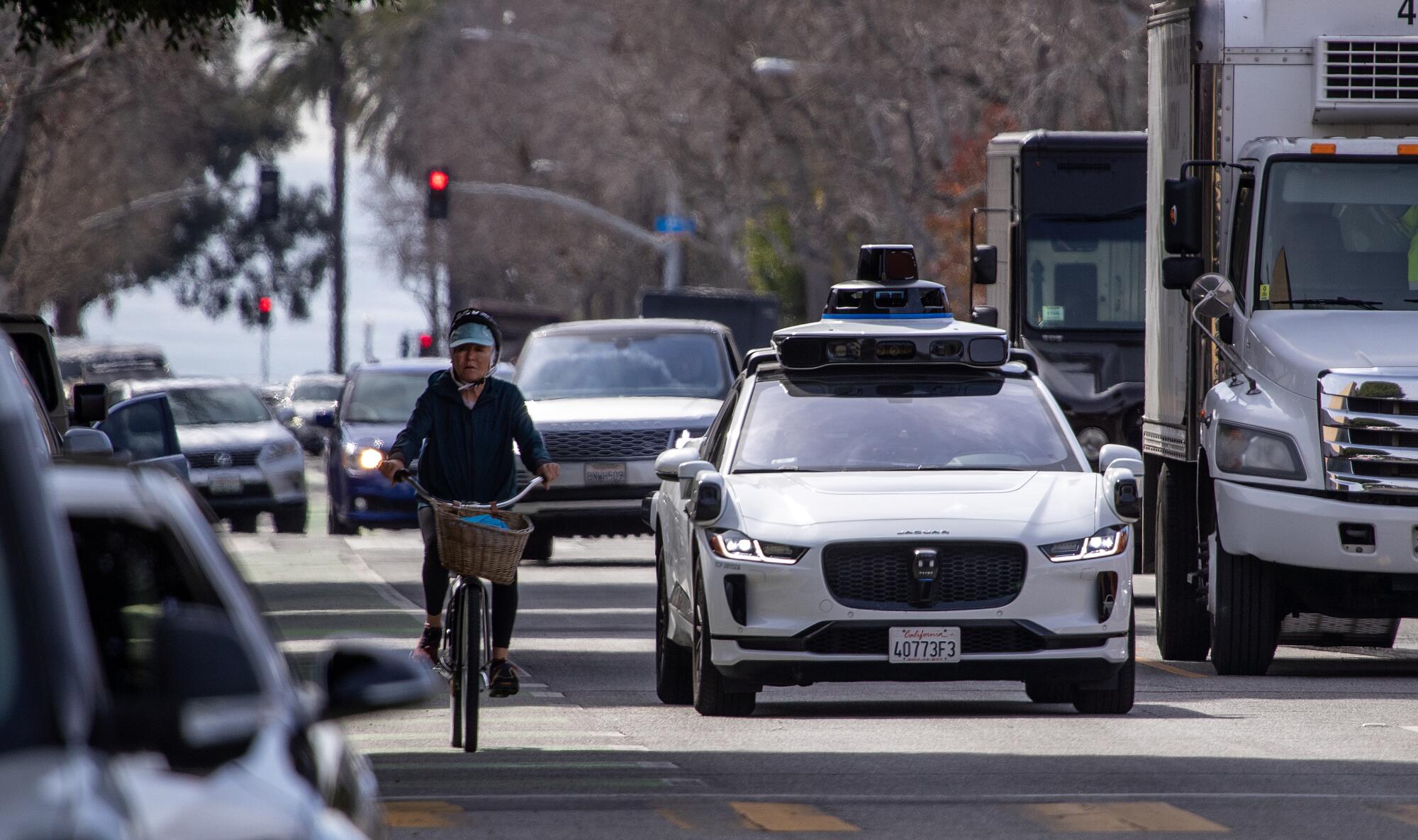
The DMV launched an investigation in 2021 into whether Tesla falsely markets its autonomous technology. The company brands it as “full self-driving” but California does not regulate Teslas as autonomous vehicles, so the company doesn’t have to report crash data to the state. The DMV’s investigation has yielded no public results in more than 2½ years, to the frustration of some state lawmakers.
The governor also clashed with lawmakers over autonomous vehicles earlier this year when he vetoed a bill to require human safety drivers in self-driving big-rig trucks — a measure that sailed through the Legislature with bipartisan support. Newsom said the bill was unnecessary because of the state’s existing system for regulating the evolving technology.
“DMV continuously monitors the testing and operations of autonomous vehicles on California roads and has the authority to suspend or revoke permits as necessary to protect the public’s safety,” he wrote in the veto message.
Peter Finn, a vice president of the International Brotherhood of Teamsters, which sponsored the bill to require human drivers on autonomous trucks, said the union will keep pushing because both safety and jobs are at stake.
“We’re not backing away from this fight. We’re going to double down in terms of pursuing fair and responsible guardrails to this technology,” he said.
He called Newsom “completely out of touch with California residents” on the issue of autonomous vehicles.
There’s no sign that Newsom’s zeal for automotive innovation will subside. In addition to touring the Shanghai Tesla factory, while in China Newsom test drove a hybrid SUV made by Chinese manufacturer BYD. He took his hands off the wheel and waved to reporters as the car went into automated mode and rotated in a full 360-degree turn.
“This is another leap of the technology. Next level,” Newsom marveled from behind the wheel of the vehicle, which played the Eagles’ song “Hotel California” on the sound system when he turned it on.
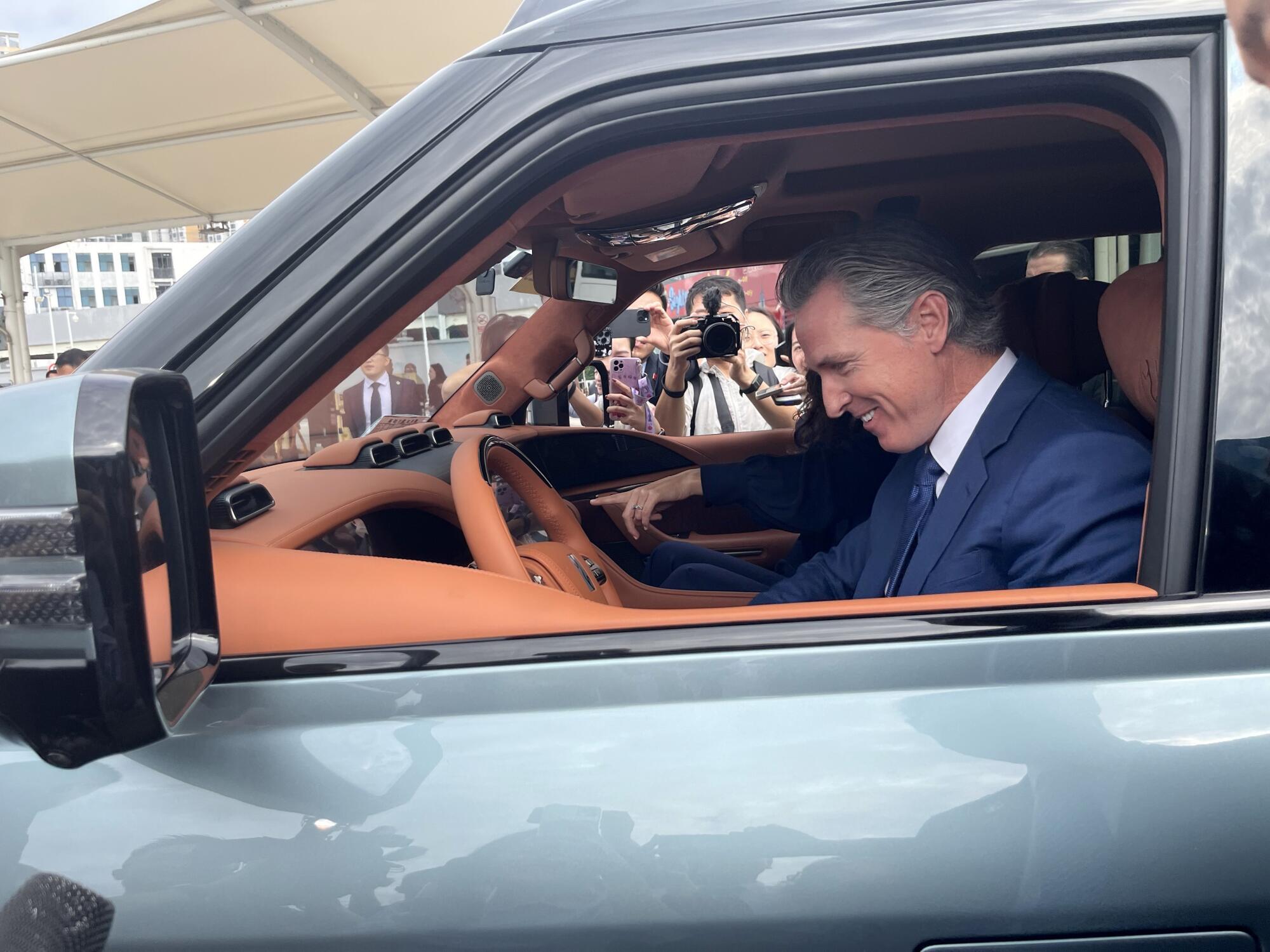
The governor said he first experienced driverless technology many years ago during a visit to Google with company founders Sergey Brin and Larry Page. Four years ago, at the Sears Point raceway in Sonoma County, Newsom said he rode in an “Audi going 160 miles an hour with no one in the driver’s seat.”
Newsom also expressed excitement about aviation innovation underway in California. Drone-like electric planes are being tested across the state by Silicon Valley tech companies pitching the vision of clean, quiet flying taxis to get people off clogged freeways. Two companies, Archer and Joby, plan to launch with pilots while a company called Wisk is developing an autonomous air taxi.
Joby reported hiring a Sacramento lobbying firm for the first time in July, and one of its lobbyists, Michael Picker, is a former president of the Public Utilities Commission, which regulates taxis and rideshare companies.
Asked if he had safety concerns with autonomous technology, the governor echoed industry talking points that human drivers who can get drunk or sleepy behind the wheel are more dangerous than driverless cars.
“I think we’re gonna look back in 20 to 30 years and go, why were we allowed to drive? And allow 30-plus-thousand Americans to die every single year in accidents?” Newsom said. “There’s a precision with the technology, but it has to be worked through. I just think it’s mesmerizing, the change that’s about to come.”
Times staff writer Anabel Sosa contributed to this report.
- Share via
Watch L.A. Times Today at 7 p.m. on Spectrum News 1 on Channel 1 or live stream on the Spectrum News App. Palos Verdes Peninsula and Orange County viewers can watch on Cox Systems on channel 99.
More to Read
Sign up for Essential California
The most important California stories and recommendations in your inbox every morning.
You may occasionally receive promotional content from the Los Angeles Times.
